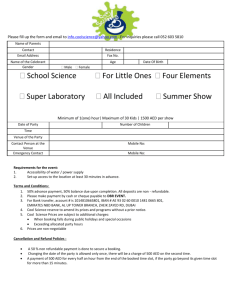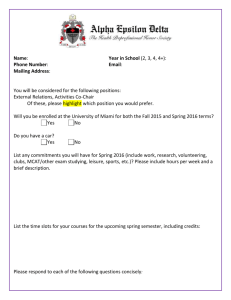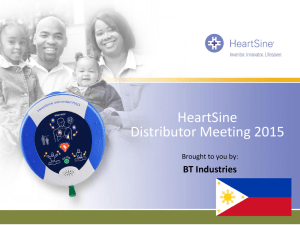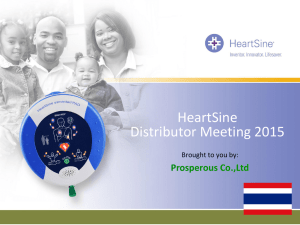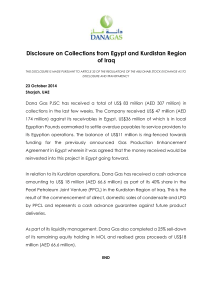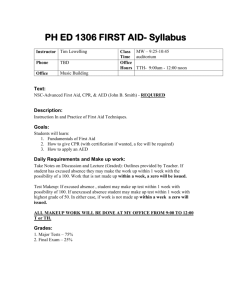A – Accident and First Aid – Defibrillator (W)
advertisement
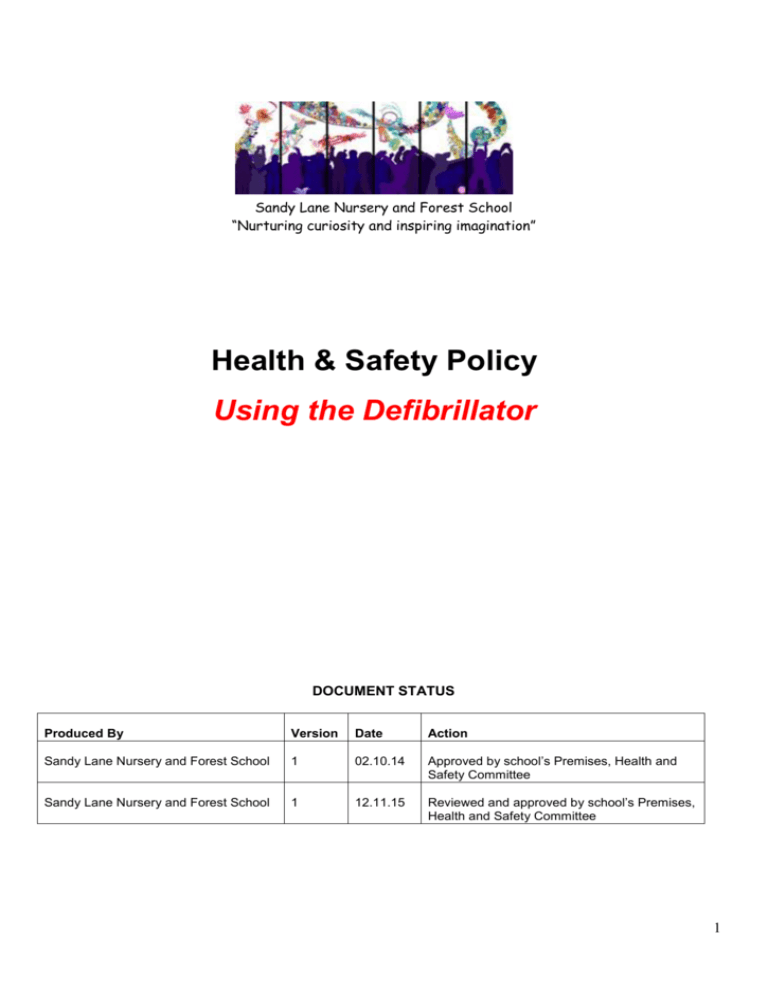
Sandy Lane Nursery and Forest School “Nurturing curiosity and inspiring imagination” Health & Safety Policy Using the Defibrillator DOCUMENT STATUS Produced By Version Date Action Sandy Lane Nursery and Forest School 1 02.10.14 Approved by school’s Premises, Health and Safety Committee Sandy Lane Nursery and Forest School 1 12.11.15 Reviewed and approved by school’s Premises, Health and Safety Committee 1 2 AUTOMATIC EXTERNAL DEFIBRILLATOR (AED) GUIDELINES The purpose of this document is to establish guidelines for the placement, care and use of an Automatic External Defibrillator (AED). AEDs are portable devices used to induce electrical stimulation to the heart muscle in the event of a potential cardiac arrest. Early access defibrillation has been recognized as a significant factor in survival from incidents of sudden cardiac arrest. Adequate preparation for responding to a life-threatening emergency can save lives. Storage and accessibility The AED is located in the reprographics area in the main school office (next to the photocopier). Responsibilities of Sandy Lane Nursery and Forest School The Headteacher has overall responsibility but may delegate the following to a member of the teaching staff as designated AED officer: o Selection of employees for AED training and distribution of AED-trained employee lists as required o Coordination of training for emergency responders o Periodic maintenance of the AED o Maintaining on file a specifications/technical information sheet for each approved AED model assigned or donated to the school o Communication with medical community on issues relating to medical emergency response program, including post event procedures AED-trained employee responsibilities o Activation of internal emergency response system to provide prompt basic life support, including AED and first aid according to training and experience o Understanding and compliance with requirements of school policy, ie, Accident, First Aid and Health & Safety Policy (Child Centred) o Follow the more detailed procedures and guidelines for the AED post-event protocols What the AED does The AED is a sophisticated, reliable, safe, computerised device that delivers defibrillatory shocks to a person in cardiac arrest. It uses voice prompts to guide the user and is suitable for use by both lay rescuers and healthcare professionals. Sandy Lane Nursery and Forest School has a PowerHeat G3 Semi-Automatic AED. The PowerHeat G3 analyses the victim’s cardiac rhythm, determining the need for a shock and delivering a shock where appropriate. The voice prompts will deliver a step-by-step guide on what action to take, including when to perform manual CPR. Use of the AED An AED should be applied to any casualty who is unconscious and not breathing properly. o Any staff member who has been trained to use an AED may use the machine, provided they feel confident and competent to do so 3 Sequence of actions when using an AED 1. Make sure you, the casualty and any by-standers are safe. If two rescuers are present, assign tasks. 2. If the casualty is unresponsive and not breathing normally: o Send someone for the AED and to call for an ambulance o If you are on your own, do this yourself; you may need to leave the casualty 3. Start CPR according to the guidelines for basic life support. 4. As soon as the AED arrives: o Place the AED near the casualty’s head and switch on the AED o Attach the electrode pads. If more than one rescuer is present, continue CPR whilst this is done o Follow the voice/visual prompts o Ensure that nobody touches the casualty whilst the AED is analysing the rhythm 5. If a shock is indicated: o Ensure that nobody touches the casualty o Push the shock button as directed o Continue as directed by the voice/visual prompts 6. If no shock is indicated: o Immediately resume CPR, using a ratio of 30 compressions to two rescue breaths o Continue as directed by the voice/visual prompts 7. Continue to follow the AED prompts until: o Qualified help arrives and takes over o The casualty starts to breathe normally or you become exhausted 4 Please refer to attached appendices for AED Algorithm, Paediatric Basic Life Support and Adult Basic Life Support flowcharts, reproduced with kind permission of the Resuscitation Council (UK). Attaching the electrode pads The casualty’s chest must be sufficiently exposed to enable correct electrode pad placement, so clothing will need to be opened (buttons) or cut with shears. Chest hair may prevent the pads adhering to the skin and interfere with electrical contact. Shave the chest only if the hair is excessive and, even then, spend as little time as possible on this. Do not delay defibrillation if a razor is not immediately available. In the AED case, you will find shears and, in the accessory bag, you will find a razor and a towel to wipe the chest dry, enabling good attachment of the pads. The AED pads are labelled and show a picture for correct placement. If an ‘error’ is made, the pads should not be removed and replaced, as this wastes time and they may well not adhere adequately when re-attached. With female casualties, try to avoid breast tissue by moving the breast aside when placing the electrode pad. Special circumstances o If the casualty is in water, move to a dry surface and dry chest o If there is a lump/bump (implanted pacemaker), do not place pad over the area o In the case of a medication patch in the area, remove it and wipe the skin o Pads need to be applied in different positions for pregnant women and small children Training Training arranged initially October 2014 and refresher training annually thereafter. Maintenance of the AED The expiry date of the AED cartridge (electro pads) and the battery must be clearly noted so that replacements are available in good time. Monthly checks should be done and recorded in a maintenance log. Daily checks on the green flashing light on the machine should also be made, as well as checks to make sure all the accessories are present and in date in the accompanying accessory bag. On each occasion, the following checks must be noted: o AED has green light flashing and a pair of cutting shears in the case o Expiry date of battery and cartridge in the AED The accessory bag contains the following: o Spare adult cartridge o Resuscitation face mask for manual CPR o Razor o Towel o Disposable gloves o Accident form and pen The designated AED officer (member of teaching staff) is responsible for weekly checks of the AED. Any problems, missing items or replacement needs must be reported to the AED officer who will take appropriate action. 5 After using the AED After each use, a full check should be completed, including removal and re-insertion of the battery and replacement of used accessories. An accident report must be completed and returned to the designated AED officer. 6
